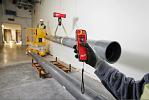- FMA
- The Fabricator
- FABTECH
- Canadian Metalworking
The evolution of the chip-breaker
The humble origins of an important advancement in cutting technology.
- By Canadian Metalworking
- February 14, 2013
Not that long ago inserts had no chip breakers. All inserts worked, provided the part and set-up were flat tops.
This created a lot of issues with chip were rigid, the machine had ample horse control. Turning was a particular issue, since in many power and the material was not “sticky” cases turning was a continuous operation and created long, stringy chips.
On the other hand milling was considered an interrupted cut and chips were not as long as turning due to the insert only cutting for half of a revolution. Naturally, turning inserts were the first to be developed with chip-breakers.
The primary function of these early chip-breakers was to curl the chip and force it to break. However, the only chip-breakers available were “G” type. For example, CNMG, TNMG, SNMG etc.
Cutting forces were generally controlled by the rake angles of the cutter. That is axial rake and radial rake. These rake angles were built into the cutter bodies, so in order to run a negative insert and take advantage of multiple edges (double-sided) the tool needed to be double negative — that is negative axially and negative radially. This allowed for clearance on the 90-degree edges.
The trade off with getting double sided inserts with multiple corners was the double negative geometry created tremendous cutting pressure and heat. (Double negative inserts by nature, such as aluminum, stainless or low carbon steel.)
Due to the nature of the operation, boring operations required positive inserts, since the tool was extended and had a tendency to chatter. During this same era, machine tool builders were making lighter duty machines with less horsepower.
These factors increased the popularity of positive geometry inserts. These inserts drew less horsepower, created less chatter, were easier on the part due to freer cutting forces, and reduced “built up edge” on the inserts since they created less heat.
The trade-off was the inserts were single-sided and had half the number of cutting edges. The popular milling inserts of this era were SEKN and TPKN.
Insert pressing technology evolved and this technology was quickly implemented into turning inserts. By producing a deep, positive chip groove on an insert it was discovered that a negative insert could have positive cutting forces. This technology meant turning inserts could be double-sided, and have lower cutting forces.
Another feature the chip-breaker provided was its ability to keep the heat from the chip out of the insert. With a flat-top insert the hot chip would slide across the face of the insert and the heat from the chip was transferred into the insert, shortening the tool life.
With chip-breakers, a small “single bump” or groove would reduce the amount of contact the chip had with the insert, and thereby reduce the amount of heat transferred into the insert, extending tool life.
Slight differences in chip-breakers produced substantial differences in performance.
Insert manufacturers began to differentiate themselves with the use of proprietary chip breakers. No longer were turning inserts labeled CNMG or TNMG, with generic breakers — the new chip-breaker designations were added to the description, such as CNMG 432-TH or TM.
Initially, chip-breakers were added to positive milling inserts and the term chip-breaker was aptly changed to “top form geometry” since its main function in milling was not to break a chip, rather it was designed to change cutting forces, direct chip expulsion, reduce heat and increase tool life.
As pressing technology evolved, insert manufacturers were able to press highly positive top form geometries on double-sided inserts. This allowed multiple cutting edges on inserts that were free cutting.
Pressing technology has evolved even further. Today some insert companies are capable of pressing unprecedented types of complex geometries.
Some of these geometries allow for double sided positive inserts. These inserts actually have clearances built into the insert itself. Rather than a traditional 90-degree angle on a double-sided insert this new technology allows for inserts to have a positive clearance angle on the insert such as 5 or 11 degrees and still be double-sided.
This technology has the added benefit of providing extra security by having the insert fit into a “dovetailed” pocket.
The dovetailed pockets adds more stability, and less chance of any insert movement. This has allowed double-sided inserts on very small boring bars and indexable drills with 6 cutting edges per insert, milling inserts with 16 cutting edges or grooving tools with 4 edges.
No longer is the term “top form geometry” applicable since this new technology applies to more than just the top form. Perhaps a better term may be three-dimensional pressing technologies?
subscribe now


Keep up to date with the latest news, events, and technology for all things metal from our pair of monthly magazines written specifically for Canadian manufacturers!
Start Your Free SubscriptionAbout the Author
- Industry Events
ZEISS Quality Innovation Days 2024
- April 15 - 19, 2024
Tube 2024
- April 15 - 19, 2024
- Düsseldorf, Germany
CTMA Economic Uncertainty: Helping You Navigate Windsor Seminar
- April 30, 2024
- Windsor, ON Canada
MME Winnipeg
- April 30, 2024
- Winnipeg, ON Canada
CTMA Economic Uncertainty: Helping You Navigate Kitchener Seminar
- May 2, 2024
- Kitchener, ON Canada





















